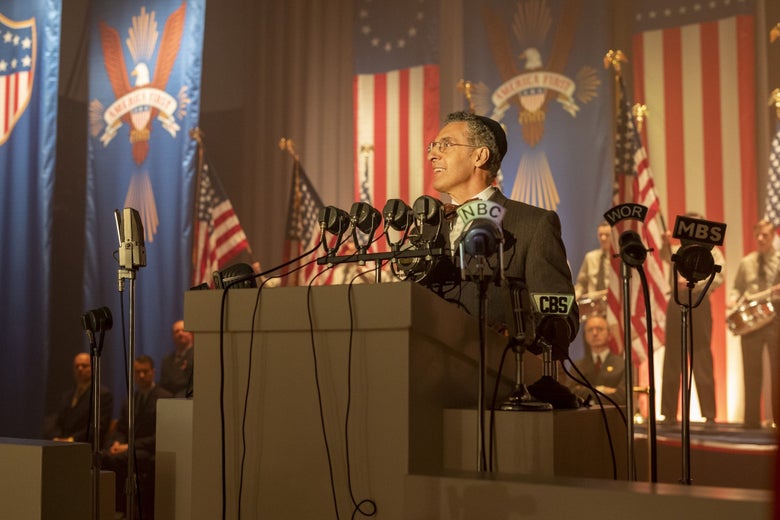
Sing along!
Michelle K. Short/HBO
The Plot Against America, David Simon’s television adaptation of the alternate history novel by Philip Roth, opens in June of 1940, as aviator Charles Lindbergh prepares to challenge Franklin Delano Roosevelt for the presidency. To set up the show’s political and social landscape, the opening credits, designed by Karen Thorson and edited by John Chimples, use newsreel footage to trace three strands of American life through the 1920s and 1930s. First, there’s Lindbergh’s status as a national hero, shown with footage from his 1927 transatlantic flight and the celebrations that followed. Second is Roosevelt’s rise in the wake of economic devastation, illustrated by footage of soup kitchens, the 1932 Democratic National Convention, and various New Deal programs. Finally, the growing threat of fascism at home and abroad is shown with familiar footage of Adolf Hitler and less familiar footage of homegrown fascists at a Nazi summer camp in upstate New York and a Nazi rally in Madison Square Garden. The whole thing is held together by a brassy arrangement of “The Road Is Open Again,” a cheerful tune that, when paired with footage of goose-steppers, becomes ominous. As with any anthem of optimism—see, e.g, “Tomorrow Belongs to Me”—the lyrics hit considerably differently depending on who is doing the singing:
There’s a new day in view, there is gold in the blue,
There is hope in the hearts of men,
All the world’s on the way to a sunnier day,
For the road is open again!
Composer Sammy Fain and lyricist Irving Kahal wrote “The Road Is Open Again” in 1933, a time when, in retrospect, the world was absolutely not on the way to a sunnier day. But although The Plot Against America’s credits use it as a sort of fascist anthem, the song actually came from the other side of the political spectrum: It was written for one of a series of short films made to promote FDR’s National Recovery Administration. (The song was so closely linked to Roosevelt that the cover of the sheet music was just a photograph of his face.) The N.R.A. was a New Deal agency that created voluntary labor codes governing things like minimum wages, working hours, and child labor; businesses that abided by the agency’s recommendations were allowed to use the logo on their stores and the products they sold or manufactured. Film studios supported the program and its codes—you have probably seen the N.R.A.’s logo and the slogan, “We Do Our Part” in movies from the early 1930s—and in August of 1932, the eight major studios agreed to each make a short film to explain and promote it.
“The Road Is Open Again” is from the Warner Bros. entry, directed by Alfred E. Green, in which Dick Powell plays a songwriter who falls asleep while trying to write a patriotic song. He’s visited by the ghosts of George Washington, Abraham Lincoln, and Woodrow Wilson, who explain how the N.R.A. works, inspiring Powell to write “The Road Is Open Again.” It is a truly bizarre bit of Americana, and you can watch it right here:
“The Road Is Open Again” made its debut on Sept. 2, 1933, when five of the studios’ N.R.A. featurettes—from Fox, MGM, Paramount, Warner Bros., and RKO—were screened at Paramount. The general public got to see them in September and October of that year, with each studio’s entry accompanying feature presentations for one week. The other films haven’t all survived—they’re mostly not even in the IMDb—but the ones that have are at least as bizarre as “The Road Is Open Again.” MGM’s entry, “Give a Man a Job,” features Jimmy Durante encouraging rich people to hire more employees to juice the economy. Here’s the advice he gives a wealthy hypochondriac:
You must get a doctor for pneumonia, a doctor for insomnia,
One for osmosis, and two for halitosis
One for anemia, and one for eczemia,
Neuritis, bronchitis, fleabitus, St. Vitus, or any other kind of an itis—that will delight us!
You must get a doctor for every disease that you’ve got.
And that will give you lots of enjoyment,
And in that way, madam, you will help to end unemployment.
The other films in the series are more difficult to see. “Mother’s Helper,” from Fox, in which Zasu Pitts discovers that her husband is planning to apply the N.R.A.’s restrictions on working hours to domestic life by hiring a younger, hotter woman to help out around the house, has survived, but isn’t online. Universal’s entry, “The Eagle and the Squawk,” was screened at a film festival in Rome, New York last year, but isn’t otherwise available. Paramount’s contribution, an untitled short in which Charles Ruggles and Mary Boland argue about the correct pronunciation of “N.R.A.,” seems to be a lost film; the same goes for RKO’s “What America Needs,” which somehow explained the New Deal by analogy to the Hobo Code. (A later RKO entry, “Signing ’Em Up,” starring comedy duo Wheeler and Woolsey, is on YouTube, but, disappointingly, it is not about hobos.) The mini-genre of N.R.A. promotional films came to an end for good in 1935, when the Supreme Court declared the agency unconstitutional. But “The Road Is Open Again” had more of a lasting cultural impact than the other N.R.A. films for a simple reason: It wasn’t just a short propaganda film made to promote a defunct government agency; it was also a record (made to promote a defunct government agency):
Now, 86 years later, the economy has once again imploded, and “The Road Is Open Again” is once again wafting from speakers all over the nation. For more parallels between America in the years leading up to World War II and the years leading up to the Trump administration, check out The Plot Against America, Mondays on HBO.
from Slate Magazine https://ift.tt/2WRSufS
via IFTTT
沒有留言:
張貼留言